Intel Core i7-11700K Review: Blasting Off with Rocket Lake
by Dr. Ian Cutress on March 5, 2021 4:30 PM EST- Posted in
- CPUs
- Intel
- 14nm
- Xe-LP
- Rocket Lake
- Cypress Cove
- i7-11700K
Gaming Tests: Far Cry 5
The fifth title in Ubisoft's Far Cry series lands us right into the unwelcoming arms of an armed militant cult in Montana, one of the many middles-of-nowhere in the United States. With a charismatic and enigmatic adversary, gorgeous landscapes of the northwestern American flavor, and lots of violence, it is classic Far Cry fare. Graphically intensive in an open-world environment, the game mixes in action and exploration with a lot of configurability.
Unfortunately, the game doesn’t like us changing the resolution in the results file when using certain monitors, resorting to 1080p but keeping the quality settings. But resolution scaling does work, so we decided to fix the resolution at 1080p and use a variety of different scaling factors to give the following:
- 720p Low, 1440p Low, 4K Low, 1440p Max.
Far Cry 5 outputs a results file here, but that the file is a HTML file, which showcases a graph of the FPS detected. At no point in the HTML file does it contain the frame times for each frame, but it does show the frames per second, as a value once per second in the graph. The graph in HTML form is a series of (x,y) co-ordinates scaled to the min/max of the graph, rather than the raw (second, FPS) data, and so using regex I carefully tease out the values of the graph, convert them into a (second, FPS) format, and take our values of averages and percentiles that way.
If anyone from Ubisoft wants to chat about building a benchmark platform that would not only help me but also every other member of the tech press build our benchmark testing platform to help our readers decide what is the best hardware to use on your games, please reach out to ian@anandtech.com. Some of the suggestions I want to give you will take less than half a day and it’s easily free advertising to use the benchmark over the next couple of years (or more).
As with the other gaming tests, we run each resolution/setting combination for a minimum of 10 minutes and take the relevant frame data for averages and percentiles.
| AnandTech | Low Resolution Low Quality |
Medium Resolution Low Quality |
High Resolution Low Quality |
Medium Resolution Max Quality |
| Average FPS | 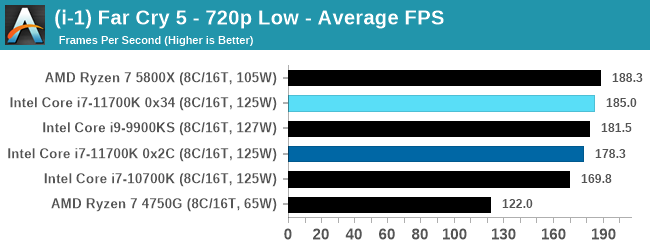 |
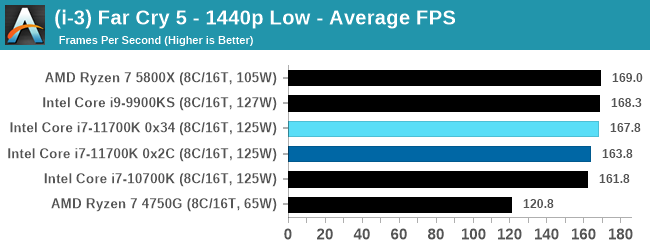 |
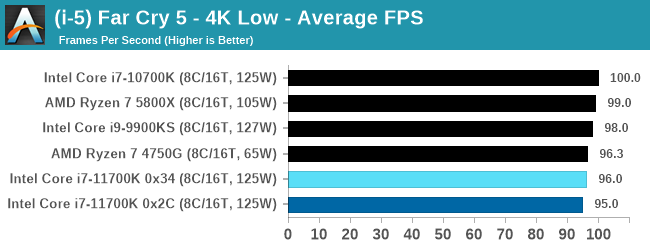 |
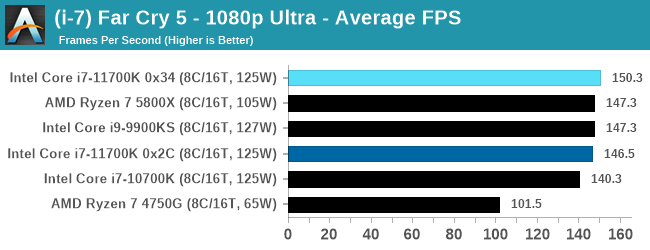 |
| 95th Percentile | 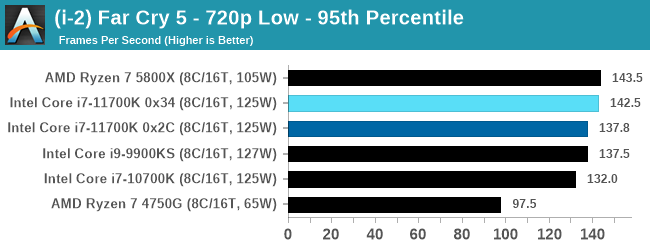 |
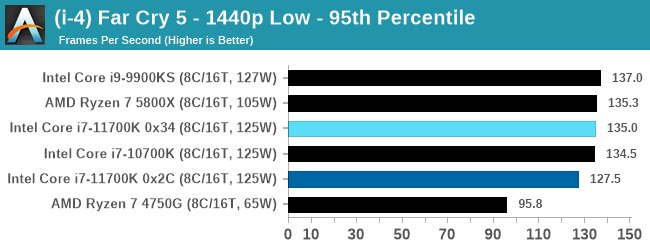 |
 |
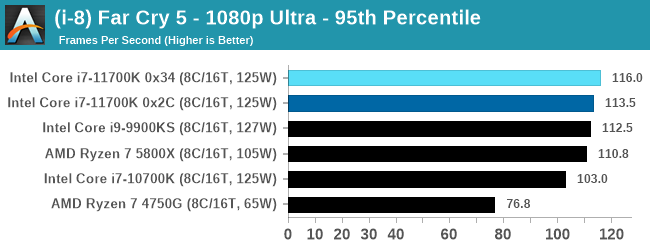 |
All of our benchmark results can also be found in our benchmark engine, Bench.












541 Comments
View All Comments
Makste - Saturday, March 6, 2021 - link
Yes. And we also got spoiled in the process. Now these are the kind of jumps we want with every release because AMD showed us that they were possible. The thrill of these performance jumps AMD has brought to the table are nothing short of exciting to the entire semiconductor realm. Things Intel should have been doing.Qasar - Saturday, March 6, 2021 - link
i read else where that the " reason " intel didnt go above quad cores, or increase performance more then 10% gen on gen before Zen, was cause if they did, then amd would of been put out of business.i would like to know is, when did/has intel ever done anything that was good for anyone other then intel ?
blppt - Sunday, March 7, 2021 - link
Well, if AMD were to go under, then Intel would be subject to increased scrutiny of being a near-monopoly. Thats probably why they would have done such a thing (if this was true).Its similar to what Microsoft did way back in the day, propping up troubled Apple with cash infusions.
Qasar - Sunday, March 7, 2021 - link
but the part is, NO one really knows what would of, or could of happened then. all it is, is one big IF.Spunjji - Monday, March 8, 2021 - link
That sounds like a rationalisation more than a reason - they had the clear motive of protecting the revenue from their "HEDT" and server processor lines. It was telling how quickly they dropped their trousers on those products after Ryzen launched.Zizy - Monday, March 8, 2021 - link
That would imply some incredibly hefty performance reserves to be unlocked when Intel felt threatened.Nah, all Intel seems to have done is to keep shrinking chip sizes at same 4C. This maybe was picked to help AMD, or just to help their bottom line. All clocks, IPC and whatever other improvements they had available were put in end products - otherwise these would be unlocked in Ice and Tiger lake, or this Rocket Lake abomination.
TheinsanegamerN - Monday, March 8, 2021 - link
The biggest reason, and thisis one thing people dont want to admit, is there was simply no reason to. Their 6 core HDET parts were consistently slower then their 4 core peasant parts in consumer applications. So spending the money on making a new die just to have 6 cores on peasant class would have been a waste of money.Cooe - Saturday, March 6, 2021 - link
Zen 2 was NOT "Zen++". Not even close. It had a ton of MASSIVE changes vs Zen 1.Sure, Zen 2 is closer to Zen 1 than Zen 3 is to Zen 2, but that's not saying much at all....
Mighty Molecule - Friday, March 5, 2021 - link
Remarkably underwhelming and disappointing. If the only distinction between 11900K and 10700K is left to binned core frequencies, you’re then left with the upgrades to PCIe 4 (which really is a designed delay from Comet Lake) and backported IPC’s at a tragic TDP. Yikes.shabby - Friday, March 5, 2021 - link
Ian can you guys start posting the actual wattage usage during each test beside the 125w rating? Would be nice seeing how much each cpu used during each specific test, if possible.